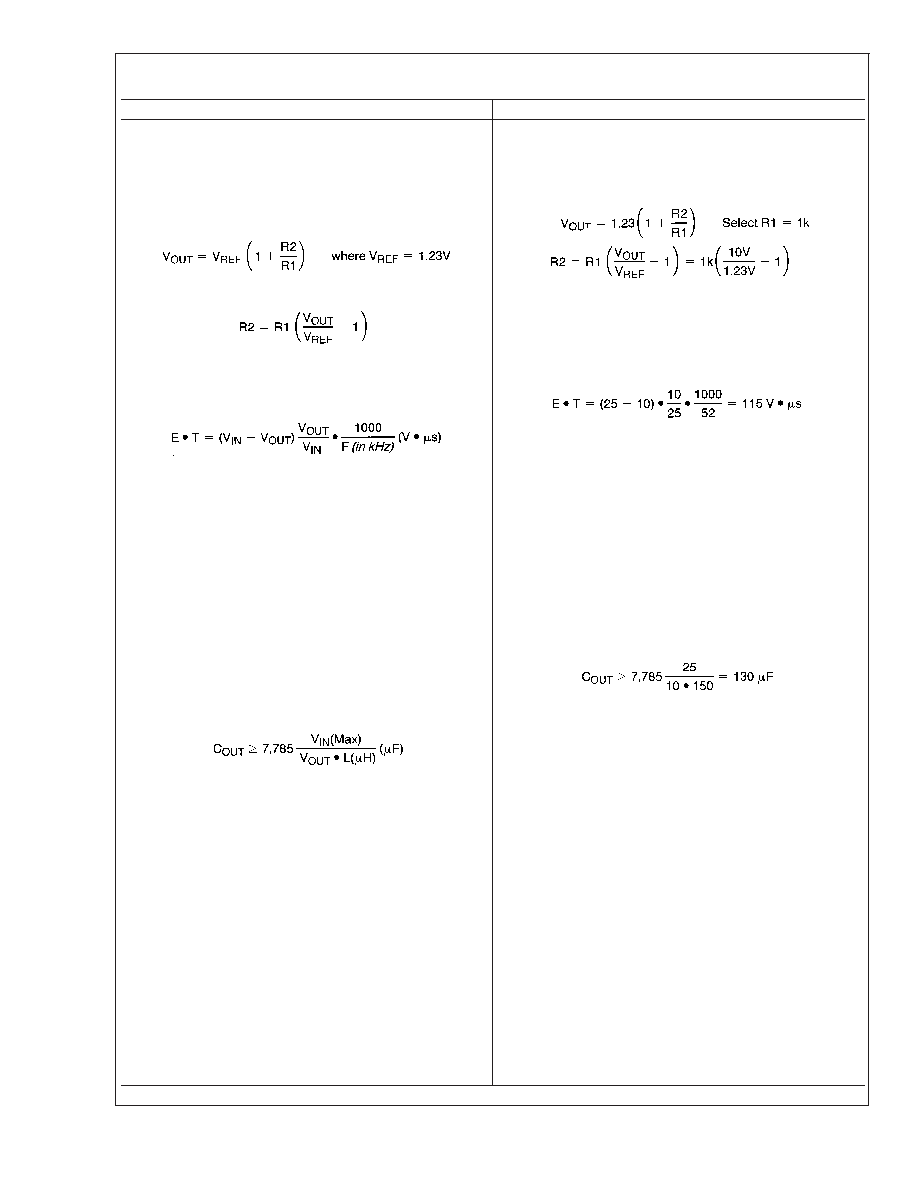- 您現(xiàn)在的位置:買(mǎi)賣(mài)IC網(wǎng) > PDF目錄30746 > LM2575M-3.3EP (NATIONAL SEMICONDUCTOR CORP) 3.2 A SWITCHING REGULATOR, 63 kHz SWITCHING FREQ-MAX, PDSO24 PDF資料下載
參數(shù)資料
| 型號(hào): | LM2575M-3.3EP |
| 廠商: | NATIONAL SEMICONDUCTOR CORP |
| 元件分類: | 穩(wěn)壓器 |
| 英文描述: | 3.2 A SWITCHING REGULATOR, 63 kHz SWITCHING FREQ-MAX, PDSO24 |
| 封裝: | SOP-24 |
| 文件頁(yè)數(shù): | 6/26頁(yè) |
| 文件大?。?/td> | 1069K |
| 代理商: | LM2575M-3.3EP |
第1頁(yè)第2頁(yè)第3頁(yè)第4頁(yè)第5頁(yè)當(dāng)前第6頁(yè)第7頁(yè)第8頁(yè)第9頁(yè)第10頁(yè)第11頁(yè)第12頁(yè)第13頁(yè)第14頁(yè)第15頁(yè)第16頁(yè)第17頁(yè)第18頁(yè)第19頁(yè)第20頁(yè)第21頁(yè)第22頁(yè)第23頁(yè)第24頁(yè)第25頁(yè)第26頁(yè)

Inductor Value Selection Guides (For Continuous Mode Operation) (Continued)
PROCEDURE (Adjustable Output Voltage Versions)
EXAMPLE (Adjustable Output Voltage Versions)
Given: V
OUT = Regulated Output Voltage VIN(Max) =
Maximum Input Voltage I
LOAD(Max) = Maximum Load
Current F = Switching Frequency (Fixed at 52 kHz)
Given: V
OUT = 10V VIN(Max) = 25V ILOAD(Max) = 1A F =
52 kHz
1. Programming Output Voltage (Selecting R1 and R2, as
shown in Figure 2 ) Use the following formula to select the
appropriate resistor values.
R
1 can be between 1k and 5k. (For best temperature coef-
ficient and stability with time, use 1% metal film resistors)
1.Programming Output Voltage (Selecting R1 and R2)
R2 = 1k (8.13 1) = 7.13k, closest 1% value is 7.15k
2. Inductor Selection (L1) A. Calculate the inductor Volt
microsecond constant, E
T(V s), from the following
formula:
B. Use the E
T value from the previous formula and match
it with the E
T number on the vertical axis of the Inductor
Value Selection Guide shown in Figure 7. C. On the hori-
zontal axis, select the maximum load current. D. Identify the
inductance region intersected by the E
T value and the
maximum load current value, and note the inductor code for
that region. E. Identify the inductor value from the inductor
code, and select an appropriate inductor from the table shown
in Figure 9. Part numbers are listed for three inductor manu-
facturers. The inductor chosen must be rated for operation at
the LM2575EP switching frequency (52 kHz) and for a current
rating of 1.15 x I
LOAD. For additional inductor information, see
the inductor section in the application hints section of this data
sheet.
2. Inductor Selection (L1) A. Calculate E
T(V s)
B. E
T = 115 V s C. I
LOAD(Max) = 1A D. Inductance
Region = H470 E. Inductor Value = 470 H Choose from AIE
part #430-0634, Pulse Engineering part #PE-53118, or
Renco part #RL-1961.
3. Output Capacitor Selection (C
OUT)A. The value of the
output capacitor together with the inductor defines the
dominate pole-pair of the switching regulator loop. For
stable operation, the capacitor must satisfy the following
requirement:
The above formula yields capacitor values between 10 F
and 2000 F that will satisfy the loop requirements for stable
operation. But to achieve an acceptable output ripple voltage,
(approximately 1% of the output voltage) and transient re-
sponse, the output capacitor may need to be several times
larger than the above formula yields. B. The capacitor’s volt-
age rating should be at last 1.5 times greater than the output
voltage. For a 10V regulator, a rating of at least 15V or more
is recommended. Higher voltage electrolytic capacitors gen-
erally have lower ESR numbers, and for this reason it may be
necessary to select a capacitor rate for a higher voltage than
would normally be needed.
3. Output Capacitor Selection (C
OUT)A.
However, for acceptable output ripple voltage select C
OUT
≥
220 F C
OUT = 220 F electrolytic capacitor
4. Catch Diode Selection (D1) A. The catch-diode current
rating must be at least 1.2 times greater than the maximum
load current. Also, if the power supply design must
withstand a continuous output short, the diode should have
a current rating equal to the maximum current limit of the
LM2575EP. The most stressful condition for this diode is an
overload or shorted output. See diode selection guide in
Figure 8. B. The reverse voltage rating of the diode should
be at least 1.25 times the maximum input voltage.
4. Catch Diode Selection (D1) A. For this example, a 3A
current rating is adequate. B. Use a 40V MBR340 or
31DQ04 Schottky diode, or any of the suggested
fast-recovery diodes in Figure 8.
LM2575EP/LM2575HVEP
www.national.com
14
相關(guān)PDF資料 |
PDF描述 |
|---|---|
| LM2575N-ADJEP | 3.2 A SWITCHING REGULATOR, 63 kHz SWITCHING FREQ-MAX, PDIP16 |
| LM2575S-3.3EP | 3.2 A SWITCHING REGULATOR, 63 kHz SWITCHING FREQ-MAX, PSSO5 |
| LM2575HVSX-3.3EP | 3.2 A SWITCHING REGULATOR, 63 kHz SWITCHING FREQ-MAX, PSSO5 |
| LM2575HVT-15EP | 3.2 A SWITCHING REGULATOR, 63 kHz SWITCHING FREQ-MAX, PSSO5 |
| LM2575HVSX-12EP | 3.2 A SWITCHING REGULATOR, 63 kHz SWITCHING FREQ-MAX, PSSO5 |
相關(guān)代理商/技術(shù)參數(shù) |
參數(shù)描述 |
|---|---|
| LM2575M-5.0 | 功能描述:直流/直流開(kāi)關(guān)轉(zhuǎn)換器 RoHS:否 制造商:STMicroelectronics 最大輸入電壓:4.5 V 開(kāi)關(guān)頻率:1.5 MHz 輸出電壓:4.6 V 輸出電流:250 mA 輸出端數(shù)量:2 最大工作溫度:+ 85 C 安裝風(fēng)格:SMD/SMT |
| LM2575M-5.0/LB03 | 制造商:Texas Instruments 功能描述: |
| LM2575M-5.0/NOPB | 功能描述:直流/直流開(kāi)關(guān)轉(zhuǎn)換器 RoHS:否 制造商:STMicroelectronics 最大輸入電壓:4.5 V 開(kāi)關(guān)頻率:1.5 MHz 輸出電壓:4.6 V 輸出電流:250 mA 輸出端數(shù)量:2 最大工作溫度:+ 85 C 安裝風(fēng)格:SMD/SMT |
| LM2575M50 | 制造商:Texas Instruments 功能描述:SWITCHING REG 1A 5.0V SMD 2575 |
| LM2575M-ADJ | 功能描述:直流/直流開(kāi)關(guān)轉(zhuǎn)換器 RoHS:否 制造商:STMicroelectronics 最大輸入電壓:4.5 V 開(kāi)關(guān)頻率:1.5 MHz 輸出電壓:4.6 V 輸出電流:250 mA 輸出端數(shù)量:2 最大工作溫度:+ 85 C 安裝風(fēng)格:SMD/SMT |
發(fā)布緊急采購(gòu),3分鐘左右您將得到回復(fù)。